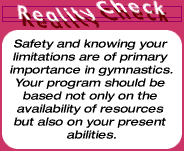Scoring with Skillful Self-challenges
Decide with your teacher which of these activities to complete:
- Standing in one spot, go through a series of turns and stretches that change your body shape. Now do this while moving around. Every 15 seconds change body shapes.
- Explore ways of mounting and dismounting a variety of objects. Before you perform any landing actions from a height, make sure you can jump in the air and land with little or no noise. Make sure that your knees bend when your toes first make contact with the floor. Try landing and freezing in your bent position. Check your knees - are they extending over your toes? If so you are putting too much stress on your knees. This time when you land, force your derriere backwards, and bring your arms forward as a counterbalance. Until you can safely land from a low height you should not move on to a higher level. Stand on a low object, like a bench or well-anchored chair. Don't use anything that is collapsible or on wheels. Now try to jump off and land on your two feet in balance.
- Now that you can land from a low height and land on your feet safely, let's try landing on your hands. This is best done on a carpet , mat, out on the soft grass-you get the idea, cement and gravel are not good landing surfaces!! While kneeling, place your hands in front of you with your arms extended at shoulder height. Make sure your elbows are relaxed and not locked straight. Now, keeping your back straight, fall forward onto your hands and absorb your weight with your hands, arms and shoulders so you are going through a push-up progression. Once you can successfully absorb your landing with control, try to fall forward to your hands from a standing position. If you can do this three times without losing control, try facing away from the landing area. When ready, twist and fall forward with control.
- Choose either a piece of tape, a roll of toilet paper, or sidewalk chalk. Now find a nice stretch of clean, flat grass. Draw a line. Can you rotate across the line? This can be done by rolling sideways, forward, backward, or hand-over-hand in a cartwheel. Standing with your feet on either side of the line. Reach your body up tall. Tighten your body. (Did you know that most of the time you can't do handstands or headstands - inverted supports - not because your arms are weak, but because your stomach muscles are not tight or strong enough?) With a taut body, place one hand on the line, then as you put the other hand down, kick your feet to land one foot at a time on the line. Your feet and legs will probably not be straight when you first do this. But keep trying until you become more confident. As you become more confident try to kick higher and higher, but always keep your stomach tight so that you are kicking in control. Before too long you will be "sticking it" on the line. This is how gymnasts learn to keep their bodies straight. Once they can stick it on the line, they try it on a bench or a low beam. Remember though, one step at a time. Let's just try to keep your feet and hands on the line first! (Note: if a straight line is too hard start with a hoop. Perform a cartwheel around the hoop. Now progress to a straighter line.)
- There are web sites available related to rhythmic gymnastics. Research what this sport involves and then try some of the moves. Using balls or hoops or ribbons on a stick, try to combine your balancing and rolling actions with this equipment. Can you roll the ball and jump over it as it travels? Can you toss the ball very high, roll and still catch the ball? Can you balance on one foot and still move the ribbon in a controlled pattern or toss the ball and catch it? If you can try to make a brief sequence of actions by combining moving, with balance, with leaping, with turns and with at least one piece of equipment. Try performing the sequence to music. It can be repeated, much like a dance.

  |
| Click on the blue oval above to view the technique. |
page 3 of 3
activities | health benefits | cooperation | do it daily for life
